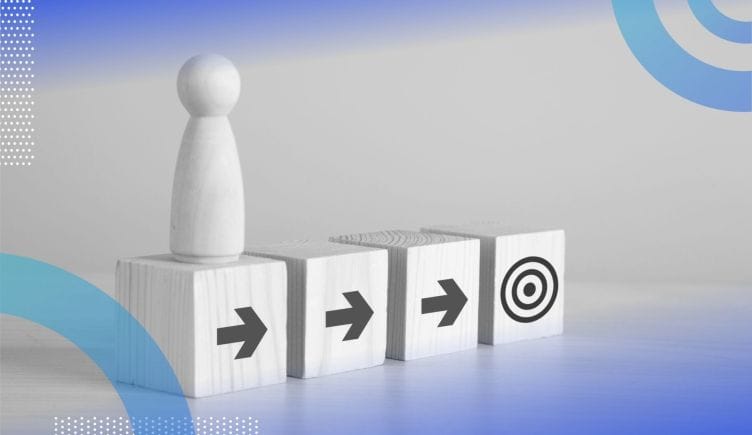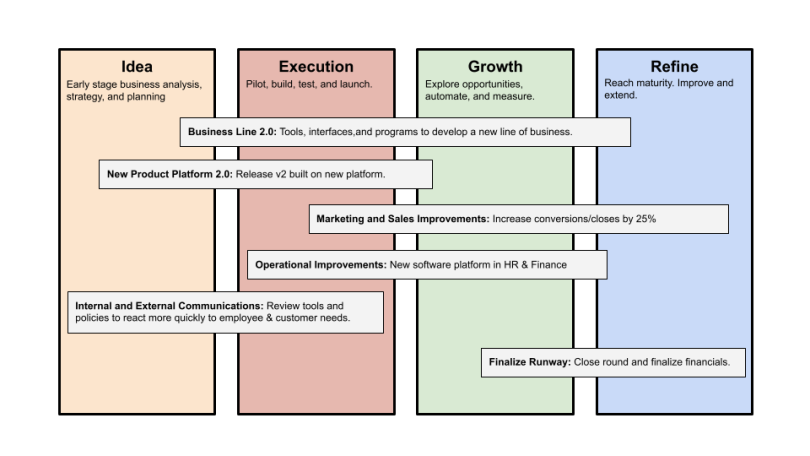Startups: Turning Goals Into Actions
Startups, This Is How to Turn Goals Into Actions
Here’s a simple tool that I use to help startups, including my own, turn their plans into reality.
Look, any experienced CEO, advisor, or investor will tell you, “Set your goals and hit your goals.” And that’s great. I’m all for goals. And you should set them. Plenty of them.
But then what?
The best startup leaders have a portfolio of goals — from three-year plans to documented lists of annual, quarterly, monthly, even weekly goals, updated as they evolve from cycle to cycle.
Regardless of the actual content of the goals, if at the end of the day leadership is just telling the team to work harder to keep the doors open, it’s only going to encourage the inevitable closing of those doors, and crush spirits as they swing shut. For goals to actually matter, to the company and to employees, they must be broken down into actionable steps that everyone understands and whose purpose in furthering the company’s mission is clear.
Distilling Goals Into Action Items Is a Critical Leadership Function
I’ve been involved with too many startups who are proud of the goals they’ve written out, frame them and post them online, make sure everyone knows them and can repeat them — and then nobody ever thinks about them again.
Whether the goal is a revenue number to hit or a new market to enter or a new line of business to launch — I’ve seen all kinds of big and brash goals drawn up over all-day meetings and week-long retreats — too often the result is the same. Every single employee then goes back to exactly what they were doing every day without really understanding whether their daily effort aligned with any of those shiny new goals.
I don’t have to tell you what happens next. The end of the quarter sneaks up on everyone and there’s that last minute rush to do whatever is necessary to come as close to that number/launch/sale as possible, because the chances of actually hitting the goal died the day after it was communicated and forgotten.
Defining the Right Tasks to Achieve Goals
Years ago, a fellow founder and I were talking about startup culture and productivity, and he said something that has stuck with me ever since:
“I’d rather have my key employees work an hour a day on the right goal than 12 hours a day on the wrong goal.”
Yeah, it’s not the theory of relativity or anything, but it’s still a valuable insight. What he’s talking about is when structure gets in the way of vision. That’s what happens when there’s a gap between goals and actions. No one takes the time to distill those goals down to milestones. On one side there’s this big fluffy list of desires, and on the other side there’s the cold, hard reality of a Gantt chart of deadlines.
It’s not easy to reconcile those two disparate things. But I’ve come up with a schema, at least.
The Goals and Initiatives Roadmap
For the last several years, I’ve been working with a goals and initiatives roadmap I developed as a communication tool while advising VC-backed, growth-stage startups. It has one purpose: To map the documented goals across stages, to initiatives, programs, and projects.
The timeline is (almost) irrelevant. Deadlines aren’t the point here, only progress. There will be plenty of time to think about deadlines when this plan is distilled down into roadmaps and project plans.
For standards’ sake, I usually have one plan for the year and one for each new quarter. Along the top, we have four stages of goal achievement, roughly matching the stages of product development.
THE 4 STAGES OF GOAL ACHIEVEMENT
- Idea
- Execution
- Growth
- Refinement
IDEA:
The initiatives that will be undertaken to hit the goal are clearly defined. This includes early-stage business analysis, strategy, and planning. In other words, if the goal is to increase revenue by 25 percent this quarter, the goal doesn’t leave the idea box until you figure out how.
EXECUTION:
The initiatives to hit the goal are underway. This is pilot, build, test, and launch. If the goal is to get a major new version of software out or a marketing campaign underway, it doesn’t leave this box until the thing is out there in the public or kicked off internally.
GROWTH:
The initiatives to hit the goal are doing what they’re supposed to do. Here we’re exploring opportunities, automating the work (so we can scale), and measuring the results.
REFINEMENT:
We’ve hit the goal. Now what? We improve and extend by refining initiatives and programs and looking for ways to scale.
Each block across is a goal, defined and communicated in whatever manner and means you like. The goal is made up of several initiatives, programs, projects — whatever it takes for your team to hit that goal.
The key is to treat each goal like a product. Define it clearly, execute it perfectly, scale the results, and refine it once you hit it. The initiatives, programs, and projects that get you there can then be carried out such that the outcome is “achieve the goal,” not “finish the project.” This way, everyone understands why they’re doing what they’re doing each day.
Now, as you might imagine, each of those initiatives, programs, and products live on your product roadmap and in your project plans, tracked by timelines, updated in status meetings, or managed however you want to manage them. What the goal and initiatives planner does is help ensure that all of those initiatives, programs, and projects are aligned with your startup’s goals from the top all the way down to the last person doing the least work on the smallest task.
Now you’re not wasting any time, and your key employees can work all day towards the right milestones and the right goals.
References
Alamäki, A., Rantala, T., Valkokari, K., & Palomäki, K. (2018). Business roles in creating value
from data in collaborative networks. In the proceedings of Pro-ve 2018, Working Conference on Virtual Enterprises (pp. 612-622). Springer, Cham.
Aldrich, H. E., & Yang, T. (2014). How do entrepreneurs know what to do? Learning and
organizing in new ventures. Journal of Evolutionary Economics, 24(1), 59-82.
Anderson, B. S., & Eshima, Y. (2013). The influence of firm age and intangible resources on the
relationship between entrepreneurial orientation and firm growth among Japanese SMEs. Journal of business venturing, 28(3), 413-429.
Assink, M. (2006). Inhibitors of disruptive innovation capability: a conceptual model. European
journal of innovation management, 9 (2), 215-233.
Atalay, M., Anafarta, N., & Sarvan, F. (2013). The relationship between innovation and firm
performance: An empirical evidence from Turkish automotive supplier industry. Procedia-social and behavioral sciences, 75(3), 226-235.
Balfour, B. (2017). Building a Growth Framework Towards a $ 100 Million
Product. Available: https://brianbalfour.com/essays/hubspot-growth-framework-100m
Baltrūnaitė, V., & Sekliuckienė, J. (2020). The use of organizational learning practices in start-ups growth. Entrepreneurial business and economics review, 8(1), 71-89







































